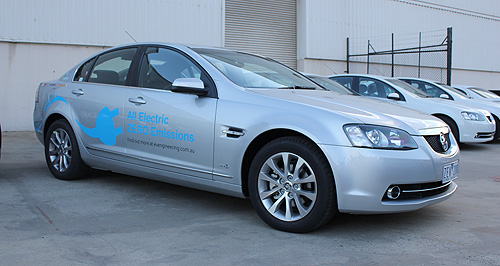Make / Model Search
News - General News - EmissionsRadical new motor for Commodore EVBright spark: The adaptive magnetic flux array motor dispenses of a separate inverter and transmission to reduce size and cost. Aussie electric motor reinvention boosts efficiency and power, shrinks size and cost14 Mar 2013 By HAITHAM RAZAGUI and IAN PORTER A MELBOURNE-based start-up will soon start trials of a radical new motor in Australia’s only electric Commodore. Smaller, lighter and less expensive than conventional units, the motor will power one of EV Engineering’s fleet of electrified Holden Commodores that feature a battery pack under the bonnet in place of a petrol engine. Developing 150kW of power and a truck-like 2800Nm of torque (compared with 145kW/400Nm for the current EVE Commodore) the new motor is also claimed to be up to 30 per cent more efficient and 36kg lighter, contributing to increased battery range. Rather than requiring a heavily modified rear sub-frame as with the current EVE Commodore, the more compact motor is hoped to fit inside a standard Holden rear differential, enabling the standard sub-frame to be retained. The motor’s more compact size is largely due to the fact its design allows it to dispense of a separate transmission and inverter electronics. Developed by Victorian electronic engineer David Jahshan and his company Axiflux, the adaptive magnetic flux array motor (AMFA) uses switching components that were prohibitively expensive until the popularity of plasma televisions brought the price down. EV Engineering – formed by a group of local car parts makers and service providers – last year converted seven Holden Commodores to electric power to demonstrate the feasibility of electric-powered large cars. Following the successful completion of the construction phase, the seven Commodores are now out on the road in the hands of interested parties, but EV Engineering has had to be scaled back in size. The AMFA project has arrived in time to dispel some of the uncertainty over EVE’s future following the announcement last month that major partner, EV charging infrastructure provider and battery swap technology pioneer Better Place, was having its Australian funding cut. EVE will help with the development of the AMFA motor by using one of its Commodores as a mobile test bed. In a system similar in concept to cylinder deactivation technology on internal combustion engines, the new motor has 23 embedded micro-controllers that automatically adjust power consumption to the immediate needs of the driver and the vehicle. Mr Jahshan said his new motor comprises 23 little segments, each controlled by its own micro-processor. This would have been prohibitively expensive a few years ago, but the cost of the processors has fallen from $50 each to around $2 now. “As I was designing the motor, whenever I ran into a problem, I would just shove in another micro-processor with the idea that I would come back to that problem later,” Jahshan told GoAuto at the Cars of Tomorrow conference. “When I completed the motor, it became apparent the multiple processors were the key to the design,” he said. Introducing the motor at the conference, EVE chief engineer Tim Olding explained that the motor was different in another aspect, as all the poles and magnets were on the same axis as the rotor. “It’s not three phase like other electric motors, it’s 23 phase, which means the system can selectively turn off, or shut down, parts of the motor.” This means the power efficiency of the motor at part load can be as high as 95 per cent, whereas other electric motors sink as low as 70 per cent efficiency under part load. Mr Olding said there were other advantages. Having the microprocessors embedded in the motor eliminated the need for a separate inverter, greatly easing the packaging problem. In addition, the characteristics of the motor are such that the car designer can do away with a gearbox and incorporate the differential into the motor unit. He said the drivetrain of the EVE Commodores weighed 97kg while a drivetrain with the new motor is expected to weigh around 60kg. Mr Jahshan, who is a visiting fellow in the electrical and electronic engineering department at Melbourne University, said he started on the project four years ago after he and his cousin decided to make their own electric car. Then he realised he needed a new electric motor that was more efficient than the motors on the market at the time. “How hard can it be to design an electric motor?” he asked himself in the time-honoured mode of inventors. Since his cousin pulled out the project, Mr Jahshan has been pushing the project along for the last three years and has won support from a range of financial backers. His company, Axiflux, is currently taking out patents around the world, partly because he believes he motor will be relatively easy to build. &ldquo.” It will use only bog-standard production techniques, well established metallurgy and normal materials,” he said. Mr Jahshan has completed two small-scale prototypes and is presently building the first full-scale, 150kW motor for bench testing. It is expected to be running in a month and in an EVE Commodore by year end. Having access to the EVE Commodore will give the motor a fast track to market compared with having to build test vehicles from scratch.  Read more11th of December 2012  Study finds EV running costs cheaperElectric vehicle costs 15 per cent of petrol, but without factoring in battery cost31st of July 2012  Supplier lands Japanese EV dealEV Commodore project helps Bosch Australia secure at least one overseas contract |
Click to shareGeneral News articlesResearch General News Motor industry news |











Facebook Twitter Instagram